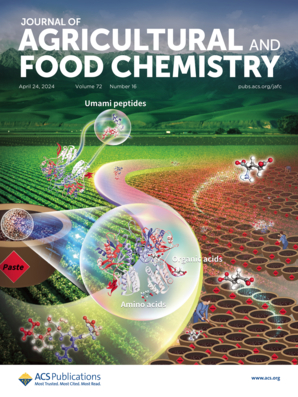Foliar Spraying of Nanoselenium Improves the Nutritional Quality of Alfalfa by Recruiting Beneficial Phyllosphere Bacteria and Regulating the Distribution and Translocation of Selenium
IF 5.7
1区 农林科学
Q1 AGRICULTURE, MULTIDISCIPLINARY
引用次数: 0
Abstract
Nanoselenium shows potential trends in improving plant health and food quality. In this study, different concentrations of nanoselenium were sprayed on the leaves of alfalfa. Compared to the control, nanoselenium (100 mg·L–1) significantly increased SeMet and SeMeCys contents in the roots, stems, and leaves of alfalfa. Nanoselenium educed malondialdehyde by modulating the glutamine synthetase-glutamate synthetase (GS-GOGAT) cycle and activating antioxidant enzymes, including the ascorbate-glutathione (AsA-GSH) cycle, as well as enhancing photosynthesis, resulting in an increase in the alfalfa yield, crude protein, and relative feeding value. The biofortification of nanoselenium mainly changed the community structure of phyllosphere bacteria by regulating metabolic pathways such as amino acid metabolism, carbohydrate metabolism, and membrane transport, among which Proteobacteria were more responsive to nanoselenium. In conclusion, nanoselenium will enhance photosynthesis, improve signaling molecules, and recruit beneficial bacteria to regulate the nutritional levels of alfalfa.

叶面喷施纳米硒通过招募有益菌群和调节硒的分布和转运来改善紫花苜蓿的营养品质
纳米硒在改善植物健康和食品质量方面具有潜在的发展趋势。在紫花苜蓿叶片上喷洒不同浓度的纳米硒。与对照相比,纳米硒(100 mg·L-1)显著提高了紫花苜蓿根、茎、叶中SeMet和SeMeCys的含量。纳米硒通过调节谷氨酰胺合成酶-谷氨酸合成酶(GS-GOGAT)循环和激活抗坏血酸-谷胱甘肽(AsA-GSH)循环等抗氧化酶,以及增强光合作用来减少丙二醛,从而提高苜蓿产量、粗蛋白质和相对饲用价值。纳米硒的生物强化主要通过调节氨基酸代谢、碳水化合物代谢和膜转运等代谢途径改变层球菌的群落结构,其中变形菌对纳米硒的反应更为明显。综上所述,纳米硒可以增强紫花苜蓿的光合作用,改善信号分子,招募有益菌来调节紫花苜蓿的营养水平。
本文章由计算机程序翻译,如有差异,请以英文原文为准。
求助全文
约1分钟内获得全文
求助全文
来源期刊
CiteScore
9.90
自引率
8.20%
发文量
1375
审稿时长
2.3 months
期刊介绍:
The Journal of Agricultural and Food Chemistry publishes high-quality, cutting edge original research representing complete studies and research advances dealing with the chemistry and biochemistry of agriculture and food. The Journal also encourages papers with chemistry and/or biochemistry as a major component combined with biological/sensory/nutritional/toxicological evaluation related to agriculture and/or food.

 求助内容:
求助内容: 应助结果提醒方式:
应助结果提醒方式:


